New Zealand discharged its last Covid-19 patient on the day that India became the fifth worst-affected country with more than 2.67 lakh confirmed cases of Covid-19. New Zealanders had united in extraordinary ways to eliminate the virus.”
New Zealand has drawn global headlines and praise from the World Health Organization for their government’s approach to the virus, with a strict and cautious approach that appears to have paid off. On 25 March they locked down the country for four weeks requiring that most New Zealanders remained at home most of the time before gradually easing restrictions.
New Zealand had reported just over 200 confirmed cases when the government shut down the country, and the total number of diagnosed instances of the virus never topped 1,500.
New Zealand had outright eliminated the virus, describing elimination as an ongoing effort.
Contrasting outcomes of rather similar lockdown measures were visible by the time India and New Zealand completed one of month of national lockdown.
Most important New Zealand did differently was following the Covid-19 protocol more strictly. New Zealand achieved one of the highest testing rates per million populations in the world
New Zealand’s government lifted all Covid-19 restrictions except stringent border controls when the nation’s health officials declared that there were no longer any known, active cases of the coronavirus remaining. New Zealanders had united in extraordinary ways to crush the virus.
India and New Zealand went for a tough lockdown around the same time. The results are, however, as different as these two countries are. New Zealand has no coronavirus cases now. Populous India’s cases are rising every day and the crisis is yet to peak.
New Zealand with a population of around 50 lakh proved easier to enforce a lockdown, especially when the per capita income is more than five time that of India’s.
When India and New Zealand announced entire lockdowns in country, health experts and international agencies applauded the move as both appeared to have taken off the block very early.
India had 519 coronavirus cases when Prime Minister Narendra Modi announced nationwide lockdown on March 25. New Zealand had 205 when its Prime Minister Jacinda Ardern put the country under lockdown.
Both countries got the first coronavirus patients from China. Both countries repatriated stranded citizens and kept them in institutional quarantine – under armed forces facilities in the early weeks of counter-Covid response.
But this is where perhaps the similarities between India and New Zealand’s meet with coronavirus ends.
India suspended flight operations from China on January 31, a day after its first case was reported in Kerala. New Zealand banned entry of travellers from China on February 3, which means 25 days before it recorded its first coronavirus case.
The citizens and permanent residents of New Zealand were only allowed to enter the country from China. Entry for people with a travel history to China was blocked, unless they had spent 14 days in a Covid-free country.
New Zealand sealed its national borders for everyone on March 15. Those entering the country had to stay in home quarantine for 14 days.
India closed its borders for travellers on March 25. It also prescribed home quarantine for travellers, but unlike New Zealand, it was foully violated here.
When New Zealand enforced total lockdown and only allowed only grocery stores, pharmacies, hospitals and gas stations to open. Vehicular movement was strictly controlled moreover Social interactions were restricted to households.
India too had similar restrictions. But the essential services had a wider sphere in India. Banks continued to function and people continued to visit them regularly.
Local vegetable markets were allowed to open where norms of physical distancing were not fallowed to properly. The strictest lockdown of New Zealand remained in force for a full month whereas in our country relaxations were announced after three weeks on the back of a critical migrant disaster.
New Zealand relaxed its lockdown from level 4 to level 3 on April 27. On April 28, New Zealand had 1,472 cases, India over 31,300. New Zealand managed to keep death count at 19. India had seen nearly 940 deaths due to Covid-19 by then.
Having a smaller population as compared to India also helped New Zealand in monitoring its Covid-affected population better. Its population is comparable to cities like Surat (45 lakh) and Pune (50 lakh) in India. Surat has around 2,200 cases of Covid-19 and Pune over 9,000 cases.

Sanjay Dutta, an engineer by qualification but is a journalist by choice.
He has worked for the premier new agency Press Trust of India and leading English daily Indian Express.
With more than a decade of experience, he has been highlighting issues related to environment, tourism and other aspects affecting mountain ecology.
Sanjay Dutta lives in a village close to Manali in Kullu valley of Himachal.





